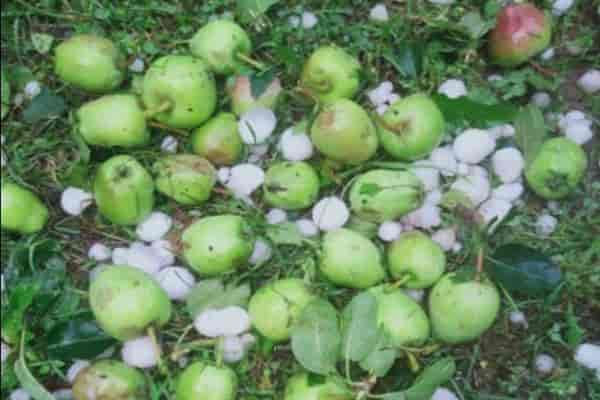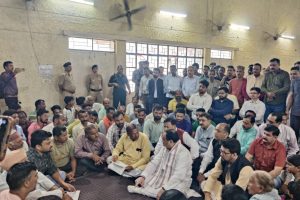Shimla: Unseasonal rains and hailstorms have caused extensive damage to the apple crop in Himachal which generates an annual income of Rs 5,500 crore in the hill state.
Sunday was the third consecutive day of incessant unseasonal rains, hail and thunderstorms battering the apple crop. The fresh round of bad weather came within four days of an earlier spell of unseasonal rain and hail which had also caused widespread destruction in the fruit belt.
Besides, the higher reaches of Lahaul-Spiti and Kinnaur have been receiving intermittent snowfall, which has brought down the temperature in Shimla and the state’s fruit belt by up to 9.9 degrees C. This is also expected to adversely impact the apple crop in the two districts.
Unseasonal rains and hail-storms have damaged apple trees and smashed the early fruit buds, according to local orchardists.
“The conditions are abnormal and unimaginable in our memories ever since Himachal Pradesh turned itself a fruit growing state. Last 43 years of my experience as an orchardist, I have not seen anything like this. The impact of climate change is very much evident, ” says Sanjay Chauhan, an orchardist and former Shimla Mayor.
Last Sunday, Ram Lal Khajaik, an orchardist from Kotkhai came down to Shimla with photographs and live videos about massive damage the orchardists have suffered due to hail.
“My crop is completely wiped –out. I have never seen such a hail and thunderstorm breaking down the plants. The hail nets put on the plants to protect the crop from natural calamities also collapsed and plants got directly exposed to the shooting hail-balls” said Khajaik as he showed pictures to Naresh Chauhan, Chief Minister’s media advisor.
“The drop in temperature and the heavy damage caused to the agriculture crops ready for the harvest due to continuous hailstorms, rains ,windstorm and lightning have cause substantial damage to the farmers in the lower hills” admits Prof S P Bhardwaj, a former scientist at Dr Y S Parmar horticulture university, Nauni,Solan.
He ,however, holds a different view in case of the apple crops and terms the condition as temporary.
“ It’s a fact that the drop in temperature has slowed down the growth of fruits. However, we hope that once the weather opens –up and temperature increases, the apple crop will certainly gain. Right now, it’s not in favourable conditions” he says.
But Sanjay Chauhan claims that 60 percent of the apple crop has suffered damage and caused losses to the farmers.There is an urgent need for the government to assess the losses, stop the recovery of loans taken by the farmers and provide them relief. The outstanding amount of nearly Rs 90 crore as arrears of the apples procured under the market intervention scheme should be released without delay.
As per S P Bhardwaj “the number of western disturbances and associated rainfall had shown an increasing trend in decades from 1971-1980 to 2011-2020. The number of western disturbances was 100 during 1971-1980, which increased to 231 during 2011-2020”.
In months of March and April, the western disturbances have left an adverse impact on the reproductive stages of the crops. Gusty winds, heavy rainfall, and hailstorms in March and April cause the shredding of grains and lodging of the wheat crop, which affects the productivity and causes major losses to farmers, he says.
The data released by the MeT department reveals that April 2023 has been the second wettest month since 2004. The state received 104.1 mm rainfall in April, 63 per cent more than the normal 64 mm received in this month. April 2021 is the wettest since 2004, having received 111.8 mm rainfall. According to the Weather Department, four active western disturbances hit the state in April, causing fairly widespread precipitation across the state.
In April, Lahaul and Spiti district received normal rainfall even as all other districts received excess rainfall. As many as eight districts received rainfall in “large excess”, recording over 60 per cent higher than normal rainfall. Bilaspur received the highest rainfall followed by Kullu and Shimla at second and third spot, respectively.




















